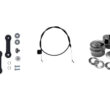Breaking the sound barrier on land is no longer a dream – it’s a reality thanks to the Bloodhound SSC. This supersonic car, designed and built in the UK, is a true engineering marvel. Powered by a jet engine and a rocket engine, the Bloodhound SSC can reach a speed of 1,000 mph in just 42 seconds. That’s faster than a bullet train!
The Rolls-Royce Eurofighter Typhoon engine produces a thrust of 20,000 pounds, while the hybrid rocket engine produces a thrust of 27,500 pounds. With a weight of 7.5 tonnes and a length of 13.4 meters, this car is a true beast.
But the Bloodhound SSC isn’t just about speed – it’s also about safety. The car has undergone numerous tests to ensure its precision and performance. It’s a testament to human ingenuity and innovation that we’ve developed such a vehicle.
Who knows what the future holds for car technology? One thing’s for sure – the Bloodhound SSC has set a new standard for speed and performance.
The quest for the fastest car in the world
For years, car enthusiasts and scientists alike have been on a relentless quest to create the world’s fastest car. The pursuit of speed has been an ongoing theme in the world of automobiles, with multiple companies and individuals putting in millions of dollars and thousands of hours of research and development to create the ultimate vehicle. Breaking the sound barrier and achieving speeds exceeding 1,000 miles per hour has remained one of the industry’s most formidable challenges.
Introducing the Bloodhound SSC: a super car in a league of its own
Enter the Bloodhound SSC, the latest contender in the race to create the world’s fastest car. This formidable supercar has been engineered to break across the sound line, reaching speeds exceeding 1,000 miles per hour. The Bloodhound SSC was conceived in 2008 by a team of engineers and car enthusiasts, led by former land-speed record holder, Richard Noble. The car is set to break the current land-speed record of 763 miles per hour, held by the Thrust SSC since 1997.
Breaking down the engineering that goes into creating a 1,000 mph car
Creating a car that travels at such high speeds requires cutting-edge technology and precision engineering. The Bloodhound SSC incorporates a number of innovative features that are designed to help it achieve its top speed. These include:
– A jet engine from a Eurofighter Typhoon aircraft and a custom-built rocket, which provide a combined thrust of 135,000 horsepower.
– A carbon-fiber monocoque chassis, which is strong yet lightweight.
– Wheels that can withstand forces of up to 50,000 g, allowing the car to travel at supersonic speeds.
– A state-of-the-art cockpit, complete with multiple screens and displays that provide real-time data on speed, altitude, and temperature.
The challenges and risks in attempting to hit 1,000 mph
Building a car that travels at such high speeds is not without its challenges and risks. The team behind the Bloodhound SSC has had to overcome numerous obstacles in their quest to create the world’s fastest car. These include:
– The need to design a chassis that is strong enough to withstand the immense forces involved in traveling at supersonic speeds.
– Finding a suitable location to test the car, which requires a flat, straight track that is at least 12 miles long.
– Developing the rocket and jet engine technology required to power the car to such high speeds.
– Ensuring the safety of the driver, who will be traveling at speeds equivalent to the take-off speed of a jumbo jet.
The need for advanced technology and innovation in designing the Bloodhound
Creating a car that can hit 1,000 miles per hour requires a level of innovation and technological advancements that are truly groundbreaking. The project has brought together experts from a range of fields, including aerospace engineering, materials science, and computer modeling. The Bloodhound SSC uses cutting-edge technology in all aspects of its design, from the carbon-fiber chassis to the rocket and jet engines. The project has also been supported by a range of technology partners, including Rolls-Royce, Jaguar, and Intel.
How the Bloodhound is pushing the limits of what we know about high-speed travel
The Bloodhound SSC represents a new frontier in the world of high-speed travel. By pushing the boundaries of what we know about aerodynamics, materials science, and rocket technology, the Bloodhound team is paving the way for faster, more efficient land-based travel. The project is also inspiring a new generation of engineers and scientists, who are learning from the team’s expertise and innovation.
The anticipation surrounding the Bloodhound’s upcoming speed tests
The world is eagerly awaiting the Bloodhound SSC’s upcoming speed tests, which are scheduled to take place in South Africa in 2022. These tests will be the first time the car has been driven at high speeds, and they will provide crucial data on the car’s performance and safety. The tests are also expected to attract a huge amount of interest from the public, with millions of people around the world following the Bloodhound’s progress.
What the future holds for the Bloodhound and the world of high-speed cars
If the Bloodhound SSC is successful in breaking the land-speed record, it will mark a significant milestone in the history of high-speed travel. The project will also pave the way for new developments in areas such as transport and energy efficiency. As the world continues to seek faster and more efficient ways of traveling, the Bloodhound SSC represents a major step forward in the field of high-speed engineering.



